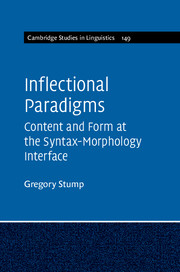Book contents
- Frontmatter
- Dedication
- Contents
- List of figures
- List of tables
- Acknowledgements
- List of abbreviations
- List of symbols and operators
- Introduction
- 1 What are inflectional paradigms?
- 2 Canonical inflectional paradigms
- 3 Morphosyntactic properties
- 4 Lexemes
- 5 Stems
- 6 Inflection classes
- 7 A conception of the relation of content to form in inflectional paradigms
- 8 Morphomic properties
- 9 Too many cells, too few cells
- 10 Syncretism
- 11 Suppletion and heteroclisis
- 12 Deponency and metaconjugation
- 13 Polyfunctionality
- 14 A theoretical synopsis and two further issues
- References
- Index
7 - A conception of the relation of content to form in inflectional paradigms
Published online by Cambridge University Press: 18 December 2015
- Frontmatter
- Dedication
- Contents
- List of figures
- List of tables
- Acknowledgements
- List of abbreviations
- List of symbols and operators
- Introduction
- 1 What are inflectional paradigms?
- 2 Canonical inflectional paradigms
- 3 Morphosyntactic properties
- 4 Lexemes
- 5 Stems
- 6 Inflection classes
- 7 A conception of the relation of content to form in inflectional paradigms
- 8 Morphomic properties
- 9 Too many cells, too few cells
- 10 Syncretism
- 11 Suppletion and heteroclisis
- 12 Deponency and metaconjugation
- 13 Polyfunctionality
- 14 A theoretical synopsis and two further issues
- References
- Index
Summary
If all inflectional paradigms conformed to the canonical ideal described in Chapter 2, there would be no reason to attribute any theoretical significance to them, since each of a lexeme's word forms could be seen as arising through a simple “spelling out” of its associated morphosyntactic properties. But inflectional paradigms rarely conform to the canonical ideal; on the contrary, there are numerous ways in which content and form may be misaligned in a lexeme's inflectional realization; such misalignments very often involve patterns defined not over individual word forms but over groups of cells within and across inflectional paradigms and potentially over entire paradigms.
A naïve inclination is to see all such cases as aberrations – that is, to see “canonical” as “normal.” But “canonical” does not mean “normal,” nor “most usual,” nor “most stable.” A canonical inflectional paradigm is like the winter solstice – a well-defined seasonal extreme relative to which a year's 364 other days can be calendrically compared, but by no means the most common or the most typical of days.
We have already seen several cases of noncanonical inflection – of mismatch between form and content in the realization of a paradigm's cells:
• Lexemes with distinct lexical meanings may have paradigms whose inflected word forms are alike in every detail (Section 4.3).
• Paradigms often exhibit morphomic patterns of exponence or stem alternation (Sections 3.6, 5.3).
• Word forms realizing the same property sets in the paradigms of different lexemes may exhibit distinct exponents for those property sets(Section 6.1).
• Paradigms may exhibit heteroclisis (Section 6.3).
Although the canonical relation between content and form in inflectional paradigms is direct and transparent (Section 2.2), deviations such as those bulleted above suggest the need for a richer architecture for modeling inflectional systems. Up to now, we have been assuming that a paradigm is a set of cells, where each cell is the pairing of a particular content with a particular word form w, and a cell's content comprises both the lexical content of a lexeme L and the morphosyntactic content of a property set σ; that is, we have been regarding a paradigm as a set of cells of the form 〈L, σ : w〉. Henceforth, however, we will pursue the richer hypothesis in (1).
Information
- Type
- Chapter
- Information
- Inflectional ParadigmsContent and Form at the Syntax-Morphology Interface, pp. 103 - 119Publisher: Cambridge University PressPrint publication year: 2015
